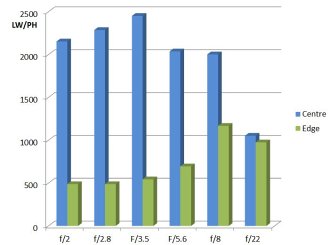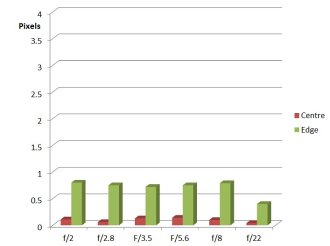MEIKE 50mm f/2.0 Mirrorless Lens Review
MEIKE 50mm f/2.0 Performance
The expectation for this lens inevitably will be set against its modest £65 price tag, although there are no electronic or mechanical complications in it so there are many areas where costs of production can be lower without necessarily sacrificing performance.
Sharpness is very good centrally at f/2 and peaks at excellent levels at f/3.5, thereafter remaining very good to f/8. It dips to only fair at f/22.
The edges are very soft, with poor sharpness at all apertures, but improving to a fair standard at f/8, and this will be even more noticeable on APS-C cameras.
How to read our charts
The blue column represents readings from the centre of the picture frame at the various apertures and the green is from the edges.The scale on the left side is an indication of actual image resolution as LW/PH and is described in detail above. The taller the column, the better the lens performance.
For this review, the lens was tested on a Panasonic Lumix G6 using Imatest.
How to read our charts
Chromatic aberration is the lens' inability to focus on the sensor or film all colours of visible light at the same point. Severe chromatic aberration gives a noticeable fringing or a halo effect around sharp edges within the picture. It can be cured in software.Apochromatic lenses have special lens elements (aspheric, extra-low dispersion etc) to minimize the problem, hence they usually cost more.
For this review, the lens was tested on a Panasonic Lumix G6 using Imatest.
The overall look of the images is very good, with nice colour, lovely bokeh and very well controlled CA (Chromatic Aberration). Distortion measures at +1.51% pincushion. CA and distortion can, in any event, be corrected in software.
Flare is also well controlled, although there is a significant loss of contrast when shooting with the sun just out of frame. There are no obvious internal reflections or image artefacts. There is no lens hood supplied, but use of one is to be recommended. They are readily available.
Value For Money
As far as Micro 4/3 format is concerned, we have a 100mm-equivalent f/2 short telephoto that could be an ideal portrait and low light lens. Central sharpness is high and provided this is where the main subject is, the lens could give a very good account of itself. It is priced around £65.
However, looking at APS-C, for very little more we have some marque lenses that also offer AF and full electronic communication with the cameras. These are also much sharper.
Under the mirrorless lens umbrella, there's the Sony 50mm f/1.8 OSS E-Mount which is available for around £199 while Canon fans will have to look at the Samyang 50mm f/1.2 as an alternative as Canon don't offer a native portrait lens. For Nikon users, there's the Nikon 32mm f/1.2 priced at £649 and Fuji camera owners can look at the Fujifilm 56mm f/1.2 for around £600.
Micro Four Thirds users have the choice of the Panasonic 42.5mm f/1.7 (£299) or the Olympus 45mm f/1.8 (£170) and Pentax users have the SMC Pentax-DA 50mm f/1.8 (£89). Canon offers the EF 50mm f/1.8 STM (£97), Sony the DT 50mm f/1.8 SAM (£119) and Nikon the 50mm f/1.8 D AF (£109).
Add your message
Please login here or if you've not registered, you can register here. Registering is safe, quick and free.
photodo Stats
428 MTF tests
74 in-depth photodo reviews
100+ users join each day
Help the lens community by reviewing or rating a lens today via our lens search
Latest Lens Reviews
- Chinon 28mm f/2.8 Vintage Lens Review
- Canon EF 70-200mm f/4L IS II USM Lens Review
- Samyang AF 85mm f/1.4 EF Review
- Sigma 70mm f/2.8 DG Macro Art Review
- Samyang AF 24mm f/2.8 FE Review
- Meike 50mm f/1.7 Review
- Tamron 70-210mm f/4 Di VC USD Review
- Lensbaby Burnside 35mm f/2.8 Review
- Asahi Super Takumar 50mm f/1.4 Review
- Asahi Super-Multi-Coated Takumar 135mm f/3.5 Review


